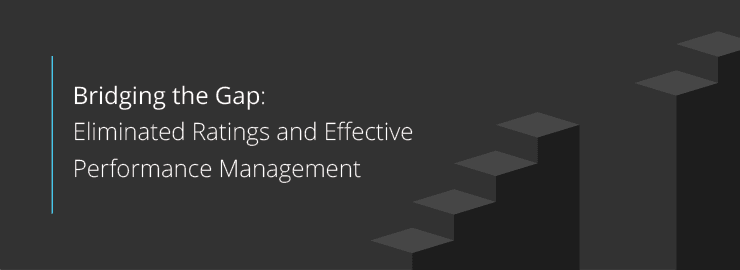A recent report from the CEB Corporate Leadership Council delivered interesting news: the “quick fix” many companies are implementing in the hopes of generating a performance management revolution isn’t working.
While enterprise leaders expect their performance management processes to improve immediately after eliminating performance ratings, it turns out they could actually worsen.
That’s the bad news. The good news is that this doesn’t mean eliminating ratings is wrong; it just means it isn’t enough. After removing ratings, organizations should focus on implementing other necessary changes to ensure that there isn’t a gap between eliminated ratings and a successful performance management process.
Organizations Are Hungry for Change
It’s becoming increasingly clear that companies want to change their performance management practices. CEB reports that a meager 4% of human resources leaders think their performance management systems are effective at accurately assessing employee performance. CEB also validates what we’ve pointed out for some time: the problem with traditional performance management approaches is that they’re hierarchical, annual, weakness-based and backward-looking. They’re also focused on measuring employees with ratings—boiling down all the skills and nuances of an employee to a number—which becomes a central point of frustration.
Employees, and many managers, don’t like ratings, and more and more organizations are now looking to do away with them—6% of organizations surveyed by CEB have already done so, 15% plan to do so in the near future and 28% say they’d consider doing so. The premise is easy to understand: get rid of the measures people don’t like, as well as the time-consuming processes that come with generating them, and manager-employee interactions will improve.
But it appears that reality falls a bit short of expectations. To prove it, CEB surveyed nearly 10,000 employees across 18 countries with a representative sample of industries and organization sizes. They gathered a variety of data, all aimed at answering this key question: “What’s the real impact of eliminating ratings?” The results may be surprising.
Just Removing Ratings Makes Things Worse
In their research, CEB found a severe mismatch between the expectations business leaders have after removing performance ratings and what actually happens in the workplace:
- Expectation: the quality of manager conversations will improve
Reality: manager conversation quality decreases by 14% - Expectation: employees will be more engaged
Reality: employee engagement drops 6%
Overall, [tweet text=”Less than 5% of managers can effectively manage employees w/o ratings.”]fewer than 5% of managers are able to effectively manage employees without ratings,[/tweet] and on average, employee performance drops 10% without ratings.
So what exactly accounts for these discrepancies? Think of it this way: eliminating performance ratings without a replacement process in mind is like getting rid of your old car without buying a new one. Sure, you won’t worry about breaking down anymore, but you also won’t be on the road at all—let alone cruising smoothly down it.
Especially because traditional performance ratings are often engrained in a company’s culture, eliminating them without teaching your organization a better way to coach and provide feedback could cause breakdowns in managers’ ability to manage and a fall in employee engagement.
Making Eliminated Ratings Count
It’s clear that dropping ratings isn’t enough to fix an organization’s entire performance management process, but what can you do to reach the expectations above?
It begins with the way conversations happen at work. First, we recommend increasing the frequency of informal conversations between managers and employees, which allows managers to provide more timely feedback and adjust expectations about what’s needed given recent organizational changes.
In their report, CEB provides advice for how to reach a more effective performance management process that aligns with our own insights on transforming traditional performance management. Combined with a few suggestions from the CEB report, here are some ways an organization can update its performance conversations™ after eliminating ratings:
- Managers should deliver frequent, ongoing performance feedback. We’ve written a lot about the value of frequent conversations, and CEB analysis shows that these conversations can improve employee performance by up to 12%.
- Performance reviews should be forward looking. [tweet text=”Performance reviews should be forward looking.”]Business conversations should focus on how to make progress towards future objectives, rather than the past[/tweet]. This not only gives managers and employees a better idea of how they’re able to meet business needs, but also how to improve their own abilities to meet those needs.
- Conversations should be two-way. No one enjoys a one-sided conversation—not even in the workplace. At the same time managers are giving feedback to their employees, employees should also be giving feedback to their managers. If employees give managers feedback, it opens opportunities to improve performance for the entire organization and not just individuals.
Our takeaway from the CEB report shouldn’t be “it’s impossible to fix my outdated performance management process” or “don’t get rid of ratings.” The real message is that you shouldn’t do anything in a knee-jerk or unsupported way. Instead, consider how you can improve your entire performance management process with structure and coaching—after you’ve eliminated performance ratings.
This week, [tweet text=”Join @odivina at the @CEB_News #ReimagineHR event in Miami on Sep. 6!”]Omar Divina, Head of our New York office, will be speaking at CEB’s annual ReimagineHR event in Miami[/tweet], where he’ll discuss in more detail about how companies can achieve high performance through operationalizing goals and feedback.






